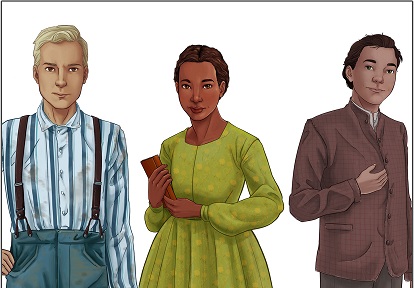1867 was the year of Confederation, when four British colonies decided to join together to become Canada. At the Village, we call the men and women who grew up at this time the “Confederation Generation”.
Play through our Class of ’67 interactive story to discover just what it was like to grow up in Confederation-era Canada. Pick a character — Ruth Barrow or Hugh McNair — and step into their shoes, as they decide the paths their lives will take.

Make choices based on real-life issues that young people like Ruth and Hugh would have faced in the mid-19th century — choices informed by their gender, family status, and ethnicity. Follow their progress as they grow into adulthood on the eve of Confederation.
Explore our Class of ’67 online exhibit to learn more about Canada at the time of Confederation — then play the game!
What choices will you make? What future will you choose?
AFTER YOU PLAY
After you’ve played the game, complete the following lessons.
Lesson 1
1. What are the differences in Ruth and Hugh’s opportunities and lifestyles?
2. What challenges do Ruth and Hugh have in common?
3. How do Ruth and Hugh’s challenges and/or opportunities differ or relate to choices you have in your life today?
Lesson 2
Ruth and Hugh are fictional characters based on the lives of real Canadians who helped to shape the country we know today.
Read the stories of real-life people from the class of ’67 below. How are their lives similar or different from those of the fictional Ruth and Hugh?
SUSANNAH MAXWELL (1805–1923)
Susannah Maxwell was born to free black parents in Pennsylvania, in the United States.
In the 1850s the United States passed the Fugitive Slave Act, which allowed for people to capture those who had escaped slavery by fleeing to “free states” (states where slavery was not permitted). Many slave catchers didn’t care if someone was a runaway or not, and kidnapped many free Black people. Susannah and her family fled to New York State after slave catchers raided her home town in 1851.
By 1858 Susannah and her family had moved to Toronto, and then to Richmond Hill. Susanna’s husband, Henry, soon died. Susannah worked as a laundress to survive, eventually opening her own laundry business with her daughters.
Susannah was a member of the Presbyterian Church in Richmond Hill, and was active in its affairs. It’s likely that she spent time in Black Creek’s own Presbyterian Manse, which was next to the Richmond Hill Presbyterian Church!
When Susannah died, she was the oldest person in Canada, at 117 years old. Her obituary was published in newspapers across the country.

WILLIAM HOLMES HOWLAND (1844–1893)
William Holmes Howland was born in Etobicoke in 1844. His father, William Pearce Howland, became Member of Parliament for York West (the area in which Black Creek Pioneer Village is located) in 1857, and was one of the Fathers of Confederation.

William attended Upper Canada College and, thanks to his father’s connections quickly became a prominent businessman, directing or presiding over more than a dozen companies by the 1870s.
In the 1870s, William became a strong advocate for policies that would protect Canadian industry and trade, which aligned him with Sir John A. Macdonald’s Conservatives. He was a member of the Loyal Orange Order, and chairman of the imperialist Canada First movement.
A deeply religious man, William was active in Protestant evangelical affairs. He became staunch supporter of the anti-alcohol temperance movement in 1877, and took an interest in prison and school reforms.
In 1886, William was elected Mayor of Toronto after running on a moral reform platform and appealing to the growing labour movement. His two-year stint in office was marked by several riots and labour difficulties.
After declining to run again in 1888, Howland began to return to his reform activities, but died of pneumonia in 1893 at the age of 49.
FOR TEACHERS: CURRICULUM LINKS
Social Studies: Heritage and Identity
- Communities in Canada, Past and Present (Grade 6)
History
- Creating Canada, 1850-1890 (Grade 8)



